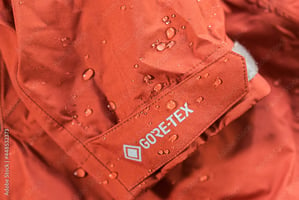Routine maintenance & care is essential to the longevity of GORE-TEX rainwear. This article details...
Step-by-Step: How to Wash Gore-Tex Properly
Information on how to wash Gore-Tex can be obtained from the Gore-Tex website or the outdoor brand's website. You may be wondering if the waterproof and water repellent properties really do not deteriorate after washing. We have washed more than 10,000 GORE-TEX garments every year, and we think we can provide you with useful information.
Discover the best way to wash your Gore-Tex garments to keep them clean, durable, and ready for your next outdoor adventure.
Understanding Gore-Tex: A Brief Introduction
Gore-Tex is a highly popular and reliable fabric used in outdoor clothing. It is known for its exceptional waterproof and breathable properties, making it the ideal choice for outdoor enthusiasts. Gore-Tex works by utilizing a unique membrane that allows moisture vapor to escape while preventing water from entering. This technology ensures that you stay dry and comfortable in various weather conditions.
When it comes to washing Gore-Tex garments, it's important to understand the fabric's construction and care requirements. By following the proper washing techniques, you can maintain the performance and longevity of your Gore-Tex clothing.
If not washed, this will accelerate the chemical deterioration of the rain jacket. It will cause the fabric to delaminate as well as the seam tape on the seams to delaminate. I do not know of any company that I know of that can repair a garment that has had the fabric delaminated.
Proper washing and storage is necessary to avoid this type of catastrophic damage.
Step 1: Preparing Your Garments for Washing
Before washing your Gore-Tex garments, it's essential to prepare them properly. Start by checking the care label for any specific instructions from the manufacturer. Some garments may require special care or treatments. Next, empty all pockets and close zippers and Velcro fasteners to prevent any snags or damage during the washing process. It's also a good idea to remove any detachable parts, such as hoods or liners, if possible.
Turn the garment inside out or put it in a net
Once the garment is ready, turn it inside out to protect the outer fabric during washing. This will not only preserve the appearance and functionality of the GORE-TEX garment, but also prevent damage from zippers and other parts hitting it. Placing the garment in a net will have the same effect. If the garment has a printed tag, turning it inside out is a good idea.
These actions reduce the mechanical force needed to clean the garment, so the cleaning power is reduced.
Turning the garment inside out and placing it in a net is very safe, but it also greatly reduces the mechanical force required to remove the dirt, so one or the other is recommended.
Step 2: Choosing the Right Detergent
When washing Gore-Tex garments, it is important to use detergents specifically designed for waterproof breathable materials. Regular detergents can clog the pores of the GORE-TEX membrane and leave a residue that can affect its water repellency. Alternatively, some may inhibit the adhesion of the water repellent during the water repellent treatment described in Step 5. Look for detergents that are specifically labeled as suitable for Gore-Tex and other technical materials.
Fabric softeners can weaken DWR performance. Avoid bleaches and harsh chemicals, as they can damage the Gore-Tex membrane. Choose mild detergents that do not contain additives or fragrances.
Step 3: Washing Your Gore-Tex Garments
When washing Gore-Tex garments, it is best to wash them on the gentle cycle of a front-loading washer. Avoid top-loading washers with agitators, as they may be highly stressful to the fabric. Set the water temperature to cold or lukewarm, as hot water can damage the GORE-TEX membrane and cause the fabric to delaminate.
Place the appropriate amount of special detergent in the washing machine according to the instructions on the package. Basically, you need to be conscious of using less detergent. Soak the collar, sleeves, and other areas where dirt is a concern with detergent in advance, then place the GORE-TEX garment in the machine and start the wash cycle.
More rinsing is desirable at this time. Three rinses are recommended. Rinse more often to remove as much detergent residue as possible.
Dehydration should be set for the shortest possible time. Gore-Tex clothing is a water-impermeable material, so it will put a heavy load on your washing machine.
When the wash cycle is complete, remove the garments promptly and do not leave them in the washer for long periods of time. Remaining detergent and water can lead to odors and mold.
The garment will still be very wet because it has not been properly dehydrated. However, do not wring or twist the Gore-Tex garment. Instead, drain excess water and hang to dry.
Drying in the sun is fine for short periods of time, but avoid prolonged drying, as UV damage will weaken the surface fabric.
Step 4: Drying and Maintenance of GORE-TEX.
After fishing-drying the fabric until the moisture is gone, an additional drying process is added.
The reason for the additional drying is to reactivate the DWR; reactivation of the DWR requires heat energy. Therefore, a dryer that can apply total heat is recommended: about 60°C for about 20 minutes.
Note that this does not make sense when wet. If heat is applied while wet, it will not be used to reactivate the DWR, but will be used to evaporate the water. As a result, DWR may end up being inadequate.
Step 5: DWR reactivation process
DWR may not reactivate even after thermal drying in a dryer. The reason for this is explained in detail in another column, in which case the garment will need to be DWR treated again.
If your Gore-Tex garment requires DWR treatment, you can use a special spray or washable water repellent treatment. Carefully follow the instructions provided by the manufacturer.
It may seem that applying a lot of water repellent will make the DWR stronger, but unfortunately it does not make much difference. Rather, it may fail and leave stains on the jacket. If such a stain is left behind, please contact a specialist.
Inspect your Gore-Tex garment regularly for signs of damage or wear. If you notice tears, holes, or delamination, try calling in a professional for repair.
Following these steps will help keep your Gore-Tex garments clean, durable, and ready for your next outdoor adventure.
Conclusion
Gore-Tex clothing is very sustainable and can last a very long time if washed properly with proper knowledge. We wash over 10,000 Gore-Tex garments each year and have included our experience in this column.
If you don't have the confidence to do all this, one thing you can do is to leave it to experts like us. My recommendation, however, is to do the day-to-day washing yourself and leave the regular maintenance to the experts. Whether you leave it to us or do it yourself, remember that maintenance is the key to maximizing the performance of your GORE-TEX clothing.



.jpg?height=200&name=vol03(1).jpg)